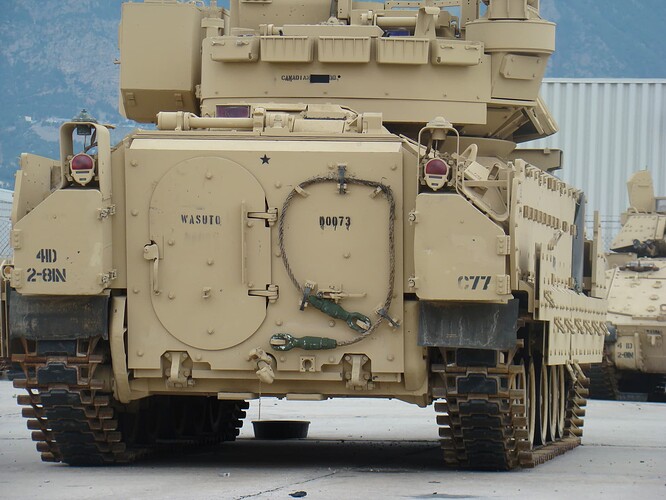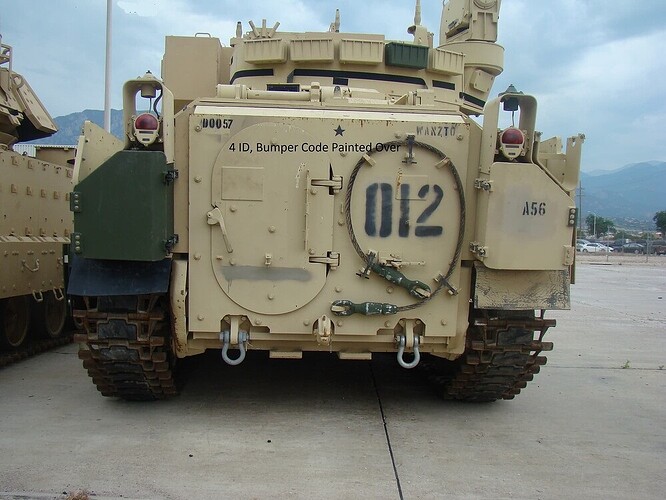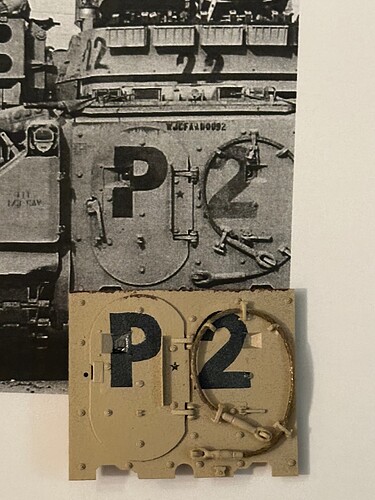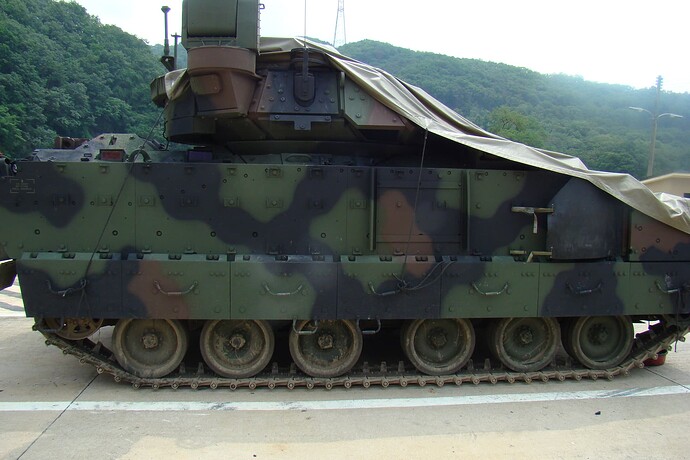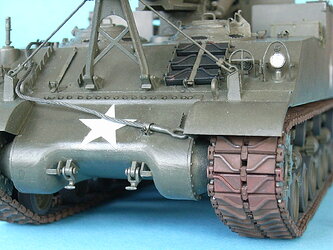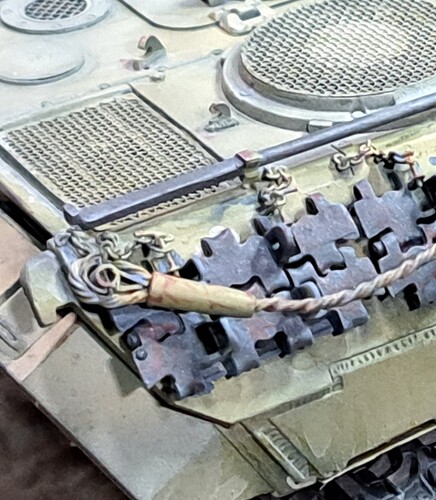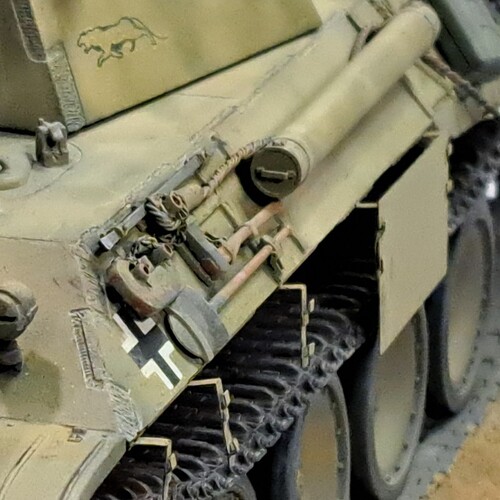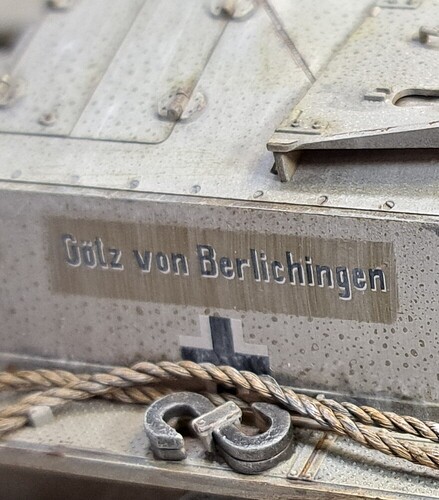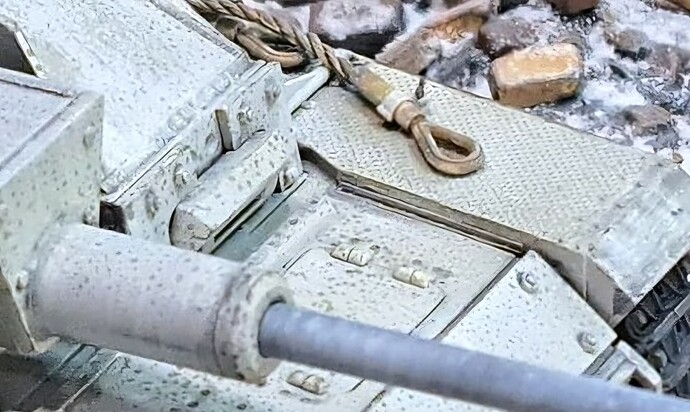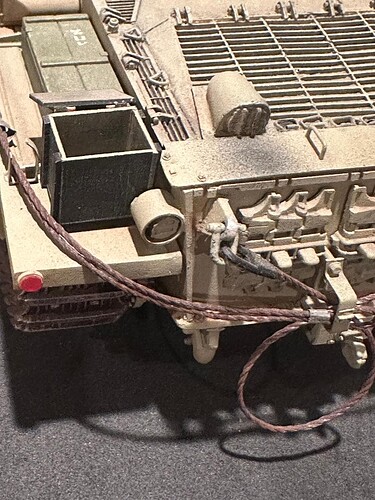Just a call out to all the great builders here. What is your technique for making tow ropes and lift cables and all the other items in this realm look great?
I guess there are no great builders watching tonight. But here’s a tip from an average builder - I’ll only use two photos as examples.
I generally paint my cables anywhere from light earth to a dark brown, depending on how rusty it is. As you can see from one of the photos, you can add a little semi gloss black to represent grease. A wash (not black!) will bring out the detail a little. Sometimes they just get painted along with the rest of the vehicle.
This is one I did about fifteen years ago. Not the best - like I said - average, but it looked better once I gave it a light dusting from underneath. I find the one of the biggest mistakes modelers make is that they weather the vehicle, and then leave rucksacks, tow bars, cables, and other other items in their original clors, as if they wouldn’t attract dust.
Still needs flat coat as well.
I’m always happy when you respond to a post. What’s a good base color to go with to get the right metal color.
Dark steel isn’t a bad start, which I’ve been known to make by mixing black and silver.
I love how I know almost all the motor pools a lot of your pics come from.
I’ve also found that using a good quality copper wire like Eureka XXL for tow cables really enhances your model. Their braid looks great. I buy their sets of wire at various diameters and cut to length as needed and drill out the kit cable ends. But they sell a lot of precut wire with resin tow ends for a specific kits.
That is the exact company that I am using now I just need to paint them and push this model off the bench
Technically it’s laid wire rope or cable. I only mention this because if you search for “braided wire” you’ll find products that look all wrong for what you are trying to model.
KL
ColdemonPL - painting tow cables is pretty decent and might be of interest.
You can make your own cables easily enough to just about any thickness. Take an old electrical cord from some broken or worn-out device and cut it open to get the thin copper wire out. Twist some strands together over a centimetre or so until you get the thickness you need for the cable, and count the number of wires it takes for that.
Put a picture-hanging hook into something solid and another in the chuck of a hand drill (I prefer a non-electric one), then take the copper wires (as many as you counted earlier) and long enough that it’s clearly longer than the cable needs to be, tie it securely to both hooks, and operate the drill until the twist looks right. Be sure to keep the wire taut at all times.
As for painting, I prefer these days to paint them a medium to dark grey colour, followed by drybrushing with lighter greys and/or metallic colours, then adding a coat of transparent grey or brown paint (not a wash).
Why not take the real thing - steel wire cable! Push bike repair shops have lots of broken brake and gearshift cables in their scrap boxes by the end of the week, and you can get any length you need of 0.8 or 1mm diameter for the asking. Anneal them in a gas flame (candles will leave soot) and let them air cool, don’t put them in cold water or similar. This will make them lose their springiness and give them the correct basic color that you can change to your wishes.
This 0.8mm one on my M40 is unpainted:
As others mentioned many great ways to do tow cables with wire etc. Metal is best etc. Eureka is very nice.
My first attempt with home brewed drill spun small gage beading wire. Strands are too big etc. Annealing is critical. Small gage copper is better etc.
FWIW in my opinion string can work OK in a bind as long as it isn’t fuzzy. A light coat of bee’s wax can help with the fuzzies. String can soak up a light, carefully applied small pin wash so some it has one characteristic that’s a plus.
The string was given a wash of gray, followed with random small light pin washes of old wood, new wood, rust & dust. When cleaning the paint brush from painting something else like tools etc was ideal for a random pin wash. Base Panzer Dark Yellow/Dunkelgelb was lightly dry brushing in various spots.
I’ve used kite string quite often. It has the correct twist, and there’s no fuzz.
I’ve used the metal as well. A lot of Voyager PE sets come with it but I don’t go out of my way to replace kit cable unless it’s really awful, i.e. any Tamiya Russian tank from the 70’s.
KL was right about the braided wire. Decades ago everyone would talk about using picture hanging wire, which I never understood. It had absolutely the wrong look. But at least they got to say they replaced the plastic cable.
Kite string is my favorite for tie-down rope and smaller cable, but I really like copper, like Eureka, for heavier gauge stuff. I anneal it over a candle flame, wipe most of the soot off and then paint it, using black/brown mixes followed by powdered graphite, then the same weathering the rest of the model gets.
I use kite string of the appropriate diameter. I like to paint it Tamiya dark iron, give it a dark umber wash, and an oily steel drybrush.
I tried that, long ago, with thin steel cable sold for making necklaces and other jewelry. I found it too stiff, making it hard to get it to bend into the shapes a real cable would have. Copper wire is much easier in this respect.
That string is really a good idea and looks quite real. I’m guessing it takes paint way better as well as glueing up to the ends.
These are all great options are there any other places outside of Eurika that make a good to scale copper rope?
Trumpeter sells a set with 55 cm of 0.8 mm copper cable and 0.35 mm copper wire.
DN Models has 50 cm of copper cable in a number of thicknesses.
I’m sure there are plenty of others, too.
